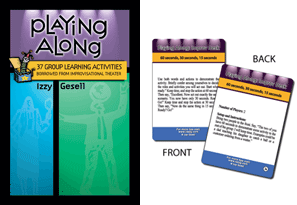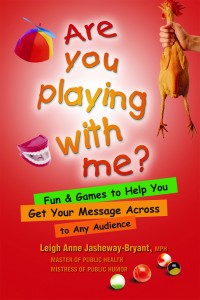Make Humor Work for You: Telling a Good Joke Well
By Izzy Gesell, M.ED, CSP
Common sense and a sense of humor are the same thing, moving at different speeds. A sense of humor is just common sense, dancing.
William James
HOW TO RECALL AND RETELL ANY JOKE YOU EVER HEAR
Barack Obama (insert any politician here) visited a nursing home during his re-election campaign for president. No one seemed to be paying any attention to him as he toured the facility. Feeling a bit frustrated, he walked up to a man in a wheelchair. “Excuse me,” the candidate said, “Do you know who I am.” The patient looked up, shook his head, and replied, “No, I don’t. But if you ask at the front desk, I’m sure the nurse will be able to help you.”
Many of us cannot successfully remember jokes because we don’t know we’re going to like a joke until after it’s over. That’s when we try to memorize it by “rewinding” the tape, but there is no tape in our memory.
A joke is an oral narrative. As such, it requires inflection, physical movement, and expression. A key to successful joke-telling is to report it as if you were telling a story to someone, a story that “really happened.” You can’t memorize someone else’s telling of a joke. You need to improvise, to sound as if you were telling it for the first time. To those that say “I can’t improvise,” I say “balderdash”(or some such word). Unless someone writes a script for you while you sleep and leaves it on your night table, then you, like the rest of us, improvise most of our conversation everyday.
Like Gaul, jokes are divided into 3 parts. Although the parts are not always clearly delineated, they are usually there.
1. THE SETUP is the reason we’re interested in the story. (Ex: Obama visited a nursing home recently in order to drum up support for his health care plan.)
2. DEVELOPMENT is a problem or difficulty that happens. (“Excuse me,” the President said, “do you know who I am.”) Jokes are never about the specific people or places they seem to be about. They are about problems and solutions. That’s why the same jokes keep coming around. I first heard this joke told about President Bush running for re-election.
3. PUNCHLINE is the solution to the problem told from a different point-of-view (In this case, the patient’s). The greater the shift in point of view, the greater the laugh. (“No, I don’t. But if you ask at the front desk, the nurse will be able to help you.”)
When you hear a joke or story you’d like to retell Write down the outline (parts 1-3) in a notebook or PDA or speak into a recorder. The key is to write the punch line down first!!!!
Transfer the outline to a 3×5 card or other system such as computer or journal.
On the other side of the card or construct a story that makes sense for you around the skeleton. Include details such as names, cities, job titles, school.
Practice reading the story to a mirror, into a tape recorder, or in front of your dog or your cat (a dog is better than a cat because at least a dog looks like it cares).
Take the card (or notes) with you, go up to someone and say something like: “I’d like to tell you a joke” and whip out the card.
Read it or refer to it. After the 1st, 2nd or 3rd time you will be telling the joke successfully because you’re not relying on memorization. You can change it around, alter details, and customize it for your audience. As long as you remember the 3 parts, you will be successful.
GESELL’S GUIDE TO GUARANTEED GUFFAW
- Don’t apologize beforehand.
- Practice, practice, practice;
- Have an air of confidence;
- Try to know your audience;
- Know you might fail (You’ll get over it!).
You don’t have to make everyone in the audience laugh (unless it’s an audience of one)
If you can only remember 1 of the 3 parts… remember THE PUNCHLINE.
SELECTED HUMOR WRITING FORMULAS
EXAGGERATION FORMULA
Description: Grossly exaggerates some (usually negative) quality of the subject of the joke. Example: The horse was so slow that the jockey kept a diary of the trip. (Henny Youngman)
REVERSAL FORMULA
Description: Punch line is 180-degree reversal of what audience might expect.
Example: I met a bum that told me he hadn’t had a bite in 3 days…so I bit him.
MISDIRECTION FORMULA
Description: Listener/reader is misled as to the outcome of a joke until the final, surprise ending. The punch line forces the audience to look at the situation from a totally different point of view.
Example: They laughed when I picked up the violin. They stopped when they realized I was from the finance company.
CLICHE REWRITE FORMULA
Description: A cliché or saying that has either been modified slightly or presented in a new context.
Example: Wall Street-the land of milk and money.
COMBINATION FORMULA
Description: Combine 2 very different elements and describe the results
Example: The director of Gandhi is making a sequel to Star Trek. It’s called “The Empire Turns the Other Cheek. ”
DEFINITION FORMULA
Description: Funny way of describing a word
Examples: Shin: A device for finding furniture in the dark. Flashlight: A case for dead batteries.
GUIDELINES FOR SUCCESSFUL HUMOR TRANSMISSION or
How to tell funny stuff in a funny way.
USE great material. Have confidence in the material. If you’re not sure its funny or you can’t tell it well, DON”T USE IT!
ENJOY the material. An exuberant manner is contagious.
SET the material up properly. Plants the seeds for the punch line, build it up and sustain interest until the climax.
KNOW your material. Added words hinder progress to the punch line. Groping for words makes the audience lose confidence in you.
EVEN though you’ve used the material 100 times, make each time seem as if you’re telling it for the first time.
MAKE it relevant. Humor that fits the occasion has a much greater chance of clicking.
KNOW your audience. Don’t offend it. Make sure your listeners are in a mood to laugh.
SPEAK distinctly. Make sure your audience understands what you’re saying.
DEVELOP rhythm, good pacing & timing. Timing is mostly about pausing and silence.
AVOID stepping on your laugh. Don’t kill the laugh-line by continuing the story. Let the laughter resonate before you continue. Don’t telegraph the punch line.
TAKE advantage of all the talents and attributes you have. Impressions, characters, odd noises, physical imperfections are humor assets when used judiciously.
TRY out your material on recorder to eliminate errors and allow for polishing the material.
BE likable and enjoyable. The more audiences like you, the better their reaction to you will be.
TIPS & TACTICS FOR USING HUMOR MORE CONFIDENTLY
Find and display a picture of yourself smiling or laughing out loud. Use it as a mirror.
Take notice of what you find humorous. What you smile and laugh at are the clues to where your sense of humor lies. Trust in yourself. Don’t judge your sense of humor solely by the opinions of others.
Gather humor where you find it so you can have it when you need it. Use a notebook or recorder to hold on to the things that make you laugh. Keep a humor diary. You will be amazed at how much laughter comes into your life already.
To your memory, an emotion is as real as the actual event. By focusing on the symbols & representations of the things that make you happy, you create REAL feelings. Carry a happiness symbol (photo, souvenir) with you. Look at it for 30 seconds when you need a smile.
Show your sense of humor in subtle but visible ways – the clothes and accessories you wear, what you place in your home or work space, quotes or cartoons in your correspondence.
Search for the happiness in others. Know what makes the people in your life happy. The more you make others laugh, the more joy will come back to you. As you expand your sense of humor and show the world you are willing to take risks with it, you will find others will desire to make you laugh.
Get a humor buddy and regularly connect with that person to share humor.
Laughter dissolves tension because laughter and tension cannot exist in your body at the same time. As a result, humor is a wonderful stress manager.
A sense of humor is more the ability to perceive incongruity or ambiguity in a situation than the ability to tell jokes. A laugh is your body’s way of saying, “aha! I didn’t expect that result, but it makes sense to me now.”
Don’t take yourself too seriously. Celebrate your individuality and your foibles. Learn to laugh with compassion at yourself and the things you do.
“A lot of truth is said in jest.” Therefore the phrase, “just kidding” doesn’t necessarily mean, “I didn’t mean what I said.”
Negative humor, such as sarcasm or ethnic humor, needs a victim. Positive humor fosters equality by focusing on shared experiences.
Humor is a skill. As such it needs to be practiced. The more you practice, the better you will become.
Check out Izzy Gesell’s book and card deck, Playing Along.
You might also like Leigh Anne Jasheway’s Are You Playing With Me? 
